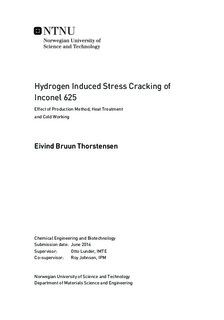Hydrogen Induced Stress Cracking of Inconel 625 - Effect of Production Method, Heat Treatment and Cold Working
Abstract
The following work has examined the effect of heat treatment, production method and cold working (CW) on the hydrogen induced stress cracking (HISC) susceptibility of Inconel 625 (UNS N06625). This was done by hydrogen pre-charging and stepwise loading in Cortest proof rings, followed by an investigation of the fracture surfaces in a scanning electron microscope (SEM). Five different versions of Inconel 625 were examined; one hot isostatic pressed (HIP), one cold worked and three forged qualities. The three forged qualities were subjected to heat treatment at 920°C, 1010°C and 1100°C, respectively. An attempt was also made to estimate the critical hydrogen concentration necessary for brittle fracture to occur in Inconel 625. This was done by combining diffusion calculations with hydrogen measurements performed by SINTEF. The critical pitting temperature (CPT) for the different versions of Inconel 625 was obtained by a modified version of the ASTM G48 test.
The forged and the HIPed versions of Inconel 625 were found to be susceptible to HISC. This was based on a decrease in strength and ductility, as well as brittle fracture surfaces and secondary cracking on the samples outer surface. The CW samples showed a higher resistance to HISC, as no reduction in fracture strength, nor any secondary cracking was observed. Forged samples heat treated at 1010°C were found to be the most susceptible to HISC, while heat treatment at 1100°C resulted in the lowest HISC susceptibility amongst the forged qualities. The amount of grain boundary carbides was found to be the main factor influencing the HISC susceptibility, where an increased amount led to a higher susceptibility. The effect of grain size on the HISC susceptibility of Inconel 625 samples charged with hydrogen is still unresolved, but the results indicate that larger grains have a beneficial effect on the ductility. The CPT was found to decrease with increasing heat treatment.
